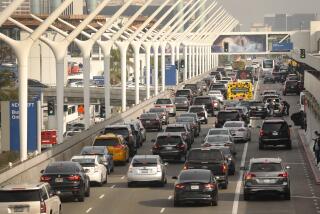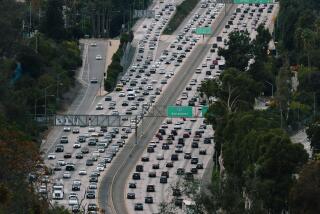Southern California is still in the slow lane, but not the slowest
At least for a time, Los Angeles and Orange counties were not the kings of traffic congestion.
A new study shows that motorists in the greater Los Angeles area in 2009 experienced fewer delays from traffic congestion than other parts of the country — a change in reputation that could be short-lived as the region recovers from the worst recession since World War II.
Released Thursday, the latest annual Urban Mobility Report from the Texas Transportation Institute states that Chicago and Washington, D.C., surpassed the Los Angeles area in the amount of time that individual motorists were stuck in traffic during peak travel periods.
Researchers found that the typical motorist in Chicago and the nation’s capitol experienced 70 hours of delay on average each year — almost two full workweeks — compared to 63 hours wasted in the Los Angeles area.
“Part of what we are seeing across the board is that the economy and unemployment have had a clear positive effect on traffic congestion,” said Tim Lomax, coauthor of the report. “Everyone is dropping. Some areas are dropping a lot faster than others.”
The report ranked the Los Angeles area No. 4 in the nation for transit improvements and No. 1 for operational improvements to streets and highways, such as carpool lanes, service patrols, traffic signal coordination and freeway ramp meters.
Researchers said the combined improvements reduced total delays in 2009 by 93 million hours and cut congestion-related costs by more than $2.2 billion.
“For us to have slipped to third place in that category is pretty significant,” said former Caltrans director Will Kempton, who now heads the Orange County Transportation Authority. “What stands out is that we have slowed the rate of growth for congestion-related delay. These improvements we’ve made are having an impact.”
But the good marks and the ascendency of Chicago and Washington are not necessarily a cause for local celebration.
Traffic is projected to increase in Los Angeles and Orange counties in the future, and the region still leads the nation in total hours of delay experienced annually by all motorists, wasted fuel, commuter stress and the cost of congestion, almost $12 billion a year.
Researchers also caution that as the economy climbs out of recession and people go back to work, the Los Angeles area could resume its No. 1 position for traffic snarls, a perch it has held 19 times since the institute issued its first report in 1984.
“It’s nice to have less congestion, but the factor that underscores this is the economic downturn,” said Paul Sorensen, associate director of the Transportation, Space and Technology Program at Rand Corp., the Santa Monica-based think tank.
The transportation institute, which is based at Texas A&M University, found that congestion-related delays have dropped overall during the last few years in the 439 urban areas it studied.
From 2005 to 2009, the average amount of time wasted in traffic across the country slipped from 38 to 34 hours per motorist. In the Los Angeles area, the delay per motorist fell 21 hours from a high of 84 in 2006.
The delay represents the difference between how long it takes to travel during peak periods compared to when traffic is free-flowing.
In once fast-growing Riverside and San Bernardino counties, researchers found that the delay per motorist fell from 37 hours in 2005 to 30 hours in 2009. The Inland Empire has been hit especially hard by high rates of unemployment and home loan foreclosures.
In Ventura County, the congestion-related delay per motorist was 23 hours in 2005, almost three times higher than in 1985. In 2009, however, the number dropped to 19 hours stuck in traffic.
Nationally, the institute found that congestion costs have continued to rise from $24 billion in 1982 to $115 billion in 2009. The cost to the average commuter was $808 in 2009, compared to an inflation-adjusted $351 in 1982.
According to the report, the total amount of wasted fuel in 2009 topped 3.9 billion gallons across the country — equal to 130 days of flow from the Alaska pipeline.
The institute recommends a balanced and diversified approach to reducing traffic congestion, one that focuses on more of everything from roads to mass transit to better urban planning that allows for walking and bicycling.
The strategies include better management of transportation systems and lifestyle changes such as ridesharing, telecommuting and flexible work hours to avoid traditional rush hours.
“It is a constant battle against congestion,” said Frank Quon, a deputy district director for operations in the California Department of Transportation’s Los Angeles office. “We need to recognize the potential for traffic to return and make the necessary investments in our transportation system.”
More to Read
Sign up for Essential California
The most important California stories and recommendations in your inbox every morning.
You may occasionally receive promotional content from the Los Angeles Times.











